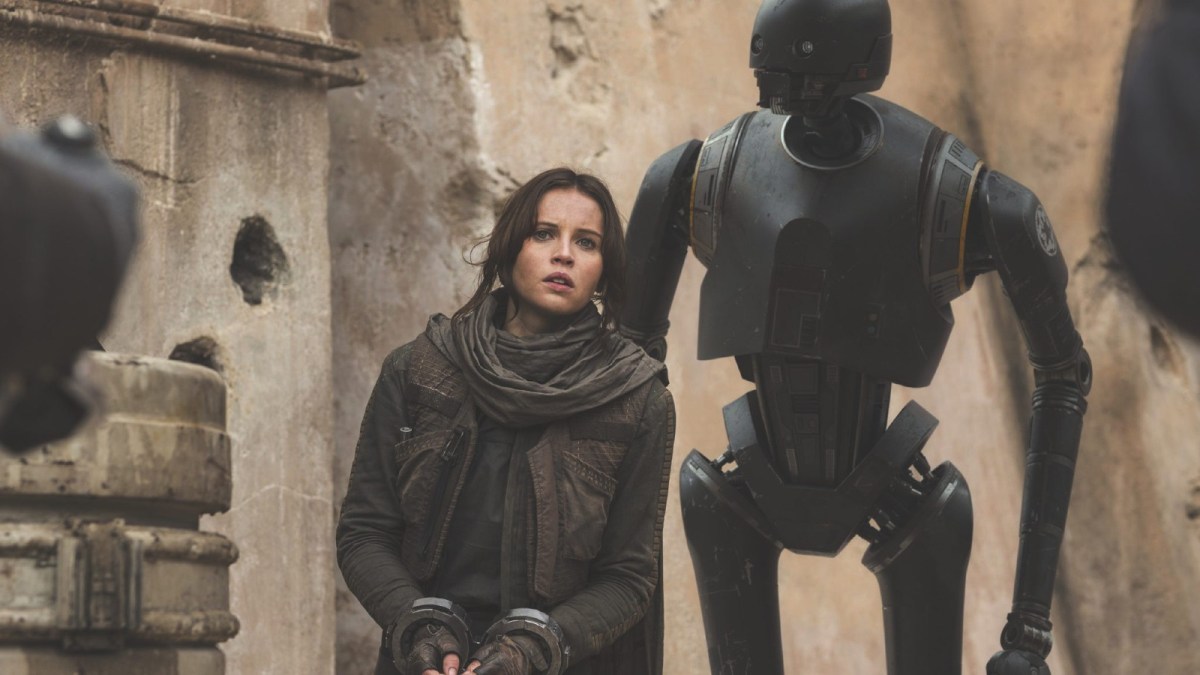Are you a Star Wars fan considering options for a movie marathon? Are you trying to get a friend or a significant other into the franchise, but you aren’t sure in which order to introduce the stories? We get it. When the original trilogy concluded in 1983, the order was pretty simple, and the home-viewing options were fairly limited. Today, the number of live-action Star Wars films has increased to the double digits, and almost half of those movies are prequels.
To help you decide, we’ve considered the three most popular options: Release order, chronological order, and the so-called machete order. We’ll give you the pros and cons of all three options and tell you which one we ultimately think is the best choice.
If you’re new to Star Wars, be warned! Plenty of spoilers follow!

Release order
No more complicated than the name suggests, watching the Star Wars saga in release order means the order in which the films were originally released in theaters.
- Star Wars: Episode IV — A New Hope (1977)
- Star Wars: Episode V — The Empire Strikes Back (1980)
- Star Wars: Episode VI — Return of the Jedi (1983)
- Star Wars: Episode I — The Phantom Menace (1999)
- Star Wars: Episode II — Attack of the Clones (2002)
- Star Wars: Episode III — Revenge of the Sith (2005)
- Star Wars: Episode VII — The Force Awakens (2015)
- Rogue One: A Star Wars Story (2016)
- Star Wars: Episode VIII — The Last Jedi (2017)
- Solo: A Star Wars Story (2018)
- Star Wars: Episode IX — The Rise of Skywalker (2019)

Release order pros
Watching the films in the order in which they came out doesn’t give us the issue that chronological order does of spoiling big reveals, like Darth Vader’s true identity. Unlike the machete order, it does so without sacrificing The Phantom Menace. It also shows us the upward track of the filmmakers’ special effects wizardry.
Release order cons
Ironically, since we were all Star Wars newbs at some point, watching the films in release order only makes sense if you’re already familiar with the story. Otherwise, the larger narrative bounces around all over the place without any real reason for it, particularly once you get to the Disney-era sequel trilogies, which get interrupted with two prequels.

Chronological order
Chronological order means watching the Star Wars films in the order in which the events depicted were meant to have occurred.
- Star Wars: Episode I — The Phantom Menace
- Star Wars: Episode II — Attack of the Clones
- Star Wars: Episode III — Revenge of the Sith
- Solo: A Star Wars Story
- Rogue One: A Star Wars Story
- Star Wars: Episode IV — A New Hope
- Star Wars: Episode V — The Empire Strikes Back
- Star Wars: Episode VI — Return of the Jedi
- Star Wars: Episode VII — The Force Awakens
- Star Wars: Episode VIII — The Last Jedi
- Star Wars: Episode IX — The Rise of Skywalker

Chronological order pros
In the case of new fans, watching the films in chronological order keeps the story clear. And for the initiated, it helps you appreciate the evolution of those characters who keep popping up. There’s something powerful about seeing Anakin Skywalker begin as a child on Tattooine all the way to his tragic end on the Death Star. Likewise, it’s fun to see Han Solo and Lando Calrissian’s first meeting in Solo before watching their reunion on Cloud City in Empire — not to mention, watching in this order lets you know just how much Han is characteristically overstating his “friendship” with Lando.
Chronological order cons
The fact that, visually, the story changes drastically in the original trilogy can be a little weird and may take you out of the story. But more than anything, the biggest downside to watching in this order is that it kills some of the best surprise reveals of Star Wars. The revelation that Darth Vader is Luke Skywalker’s father was about as stunning a fictional spoiler as you could find when Empire was released. But if you watch the films in chronological order, you’ll know Vader is Anakin long before he unveils the secret to Luke. It ruins other, smaller reveals as well, like the fact that the little green-skinned gnome on Dagobah is actually the Jedi Master Luke is looking for.

Machete order
Machete order needs a little bit more explaining. It’s named for the same blog that popularized the idea, Absolutely No Machete Juggling. Blogger Rod Hilton came up with the order in 2011. The viewing order’s main purpose is to preserve many of the reveals in the original trilogy, chiefly that Vader and Anakin Skywalker are the same person.
However, at the same time, Hilton points out that because of the changes made to the special editions of the original trilogy, toward the end of Return of the Jedi, it’s now Hayden Christensen who appears as Force-ghost Anakin Skywalker rather than Sebastian Shaw. So, if you watch the films in release order, the original trilogy ends with the ghost of a guy you have yet to meet.
His solution is the machete order. You’ll notice this order deals exclusively with the original and prequel trilogies. There’s no mention of Rogue One, Solo, or the sequel trilogies. They’re excluded for a couple of reasons. For one, Hilton came up with the machete order in 2011, before any of those films were released. Second, Rogue One and Solo are the only other prequels in the absent movies, and neither of those films spoil any major reveals in the movies that follow.
- Star Wars: Episode IV — A New Hope
- Star Wars: Episode V — The Empire Strikes Back
- Star Wars: Episode II — Attack of the Clones
- Star Wars: Episode III — Revenge of the Sith
- Star Wars: Episode VI — Return of the Jedi
The idea here is that the viewer learns Vader and Anakin are one in the same, and then Episode II and III serve as kind of extended flashbacks to show how Anakin turns bad. Watching it this way delivers the reveal in the intended manner and then introduces the viewers to Hayden Christensen as Anakin, thereby dealing with any confusion about who he is at the end of Return of the Jedi.
As you may notice, The Phantom Menace isn’t found in the machete order. Hilton argues that there is nothing crucial to the overall Star Wars saga you need to know in The Phantom Menace and that all of the new major characters it introduces (e.g. Qui-Gon Jinn, Darth Maul) are either dead by the end of the film or otherwise disappear.

Machete order pros
The machete order has a lot going for it and may very well be the best way to introduce a new fan to Star Wars. It keeps safe many of the franchise’s best reveals so they deliver the same punch. Showcasing the prequels in this way adds depth to characters like Vader, Yoda, Obi-wan, and the Emperor. It also gives a more modern feel to Star Wars. The idea of first introducing a villain, showing the evil they’re capable of, and then turning back the clocks to show how they became villains feels similar to how Breaking Bad handled Gus Fring or how Netflix’s Daredevil gave us Wilson Fisk. For those more critical of the prequels, it either minimizes or completely does away with some of the trilogy’s less popular elements, such as Jar Jar Binks and the midi-chlorians.
Machete order cons
The biggest cons to the Machete Order involve its exclusion of Episode I. Admittedly, The Phantom Menace is a flawed film, but it also features the exciting pod race on Tattooine, as well as the amazing battle between Darth Maul, Obi-wan, and Qui-Gon toward the end of the film — arguably the best lightsaber duel you’ll find in the entire saga. Also, while Qui-Gon may not be crucial to the overall plot of the trilogies, he is one of the most complex Jedi we meet in the entire saga, and his absence would be felt.
The machete order could also lead to new fans being thoroughly disappointed with the early outcome of Boba Fett’s story. The moment Boba picks up his father’s severed head in Attack of the Clones is one of the prequels’ most iconic moments, and to have that end so unceremoniously with the bounty hunter’s plunge into the Sarlacc Pit in Return of the Jedi feels like a horribly anticlimactic end.
There’s also at least one reveal the machete order doesn’t preserve — that Luke and Leia are siblings. Padme names them both before her death in Revenge of the Sith.
Winner: The machete order
While this particular viewing order doesn’t come without its bumps, as you’ve already noticed, none of the possible viewing orders are perfect. The machete order has at least one spoiler with the Luke/Leia reveal, but the chronological order doesn’t exactly keep that under wraps either. Ultimately, we’ve determined that the Luke/Leia reveal is not the most significant revelation in the series— although it does lead to plenty of kissing jokes. The machete order downplays the fate of Boba Fett in Return of the Jedi, but that was kind of a dud anyway (if we’re exclusively talking about the movies). It’s also unfortunate that we’re losing the good parts of The Phantom Menace along with the bad, but if we’re honest— there was a lot of bad.
Finally, the machete order leaves a bit of freedom for viewers: it doesn’t explicitly detail how to watch the sequel trilogy or the prequels Rogue One and Solo. You have the option to choose how you’d like to watch those films if you’re even interested in these recent chapters.
In the end, however you choose to watch Star Wars, we hope you enjoy it. And may the Force be with you.
Editors' Recommendations
- Like Amazon Prime Video’s Fallout show? Then watch three shows and movies starring Ella Purnell
- Stop! And watch these 3 great movies leaving Netflix by May 1
- Like Inglourious Basterds? Then watch these three WWII movies right now
- Like the horror movie Abigail? Then watch these 3 movies now
- 3 underrated Amazon Prime Video movies you should watch this weekend (April 19-21)




